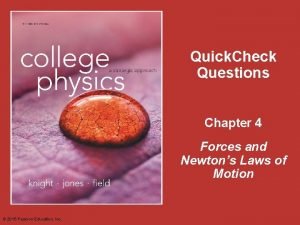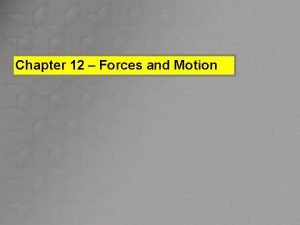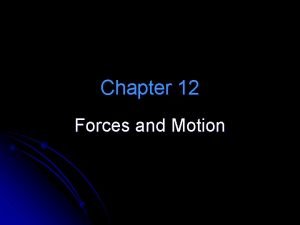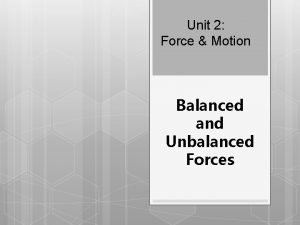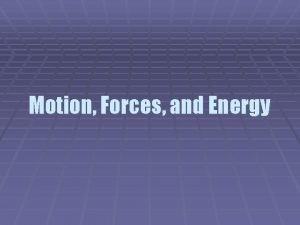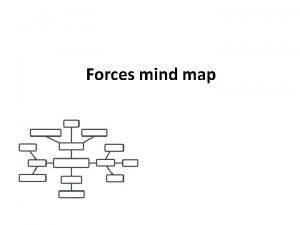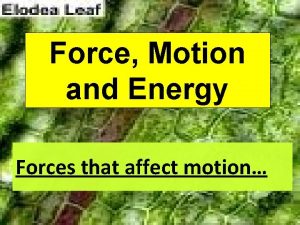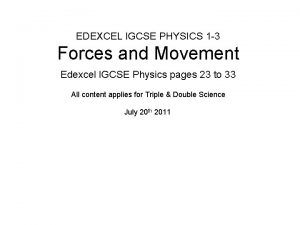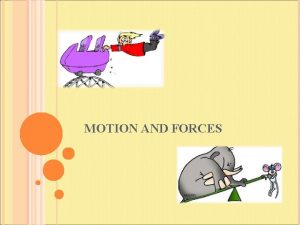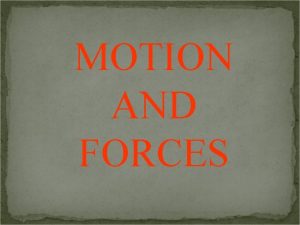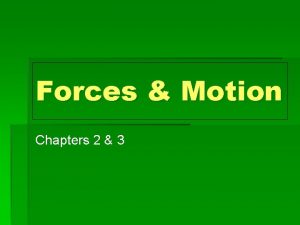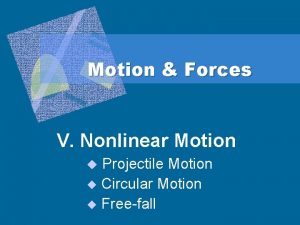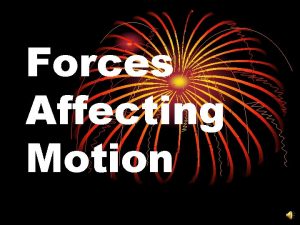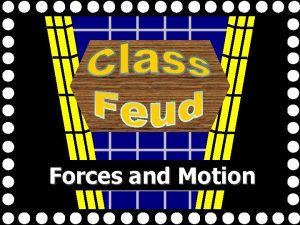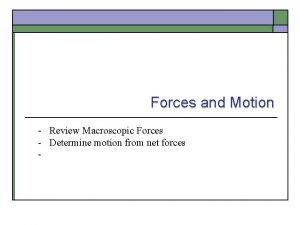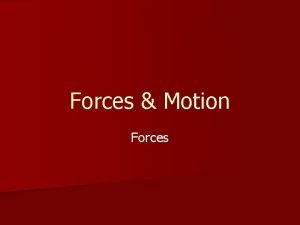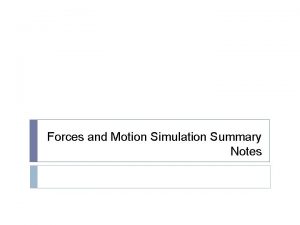Chapter 11 Forces 11 1 Forces change motion















- Slides: 15

Chapter 11: Forces 11. 1: Forces change motion 11. 2: Force and mass determine acceleration 11. 3 Forces act in pairs 11. 4 Forces transfer momentum

Warm-up Questions (T or F) • Speed includes direction, while velocity does not • A moving object covers the same distance in less time if its velocity is greater • Acceleration measures only change in speed

11. 1 Forces change motion • A force is a push or a pull – Ex: pitcher uses force to set the ball in motion, the batter uses force to change the direction of the pitched ball’s motion, and the fan stops the ball’s motion (using force) – Forces change the motion of objects

Types of Forces 1. Contact Forces: when one object pushes or pulls another object by touching it

Types of Forces 2. Gravity: force of attraction between two masses • – – – F is the force of attraction between two objects G is the universal gravitational constant; G = 6. 67*10 -11 N-m²/kg². The units of G can be stated as Newton meter-squared per kilogramsquared or Newton square meter per square kilogram. M and m are the masses of the two objects r is the distance between the objects, as measured from their centers GMm/r² is G times M times m divided by r-squared

Types of Forces 3. Friction: force that resists motion between two surfaces that are pressed together • Is in the opposite direction of motion (more on gravity and friction in chapter 12)

Forces – Push and Pull • Size and Direction of Forces – Velocity is a vector…and so is force • Has size and direction • Balanced and Unbalanced Forces – Net force: the overall force acting on an object when all the forces are combined – Knowing size and direction of all forces allows you to predict changes in the object’s motion

Forces: Balanced and Unbalanced • If the net force on an object = 0, the forces acting on it are balanced – Same effect as no forces at all • Only unbalanced forces can change the motion of an object – It doesn’t matter whether the objected started at rest or was already moving

Forces – Balanced and Unbalanced • Examples: parachutist moving at a constant speed – The forces acting on him/her are balanced

Balanced Forces • Raindrop Terminal Velocity • When the object is falling, the force of gravity is directed towards the ground and F the drag force directed upwards • As the body moves faster, the drag force becomes larger and larger until it equals F the force of gravity and the object then falls at a constant velocity drag gravity

Forces on Moving Objects • If the forces are balanced, an object can be moving at a constant velocity – Ride a bike: force you put in = force of friction • An unbalanced for is needed to change the object’s motion – To increase bike’s speed, may exert more forward force (pedal harder) – To turn, lean to one side – unbalancing the force – To stop: force of friction from brakes

Newton’s first law relates force and motion • Mid-1600’s: three laws of motion to help describe and predict motions of objects – Built on Galileo’s work, revising the ancient Greeks (push a book and it stops moving because you stopped pushing) • Galileo’s thought experiment – In the absence of friction, a moving object with continue moving even if there is no force acting on it • Meaning: it does not take a force to keep an object moving…it takes a force to stop an object that is already moving (friction) • Objects at rest and in motion both resist changes in motion • An object at rest is no different than a moving object, except an object at rest has zero velocity

Newton’s First Law of Motion • Restating Galileo’s conclusions: – Objects at rest remain at rest, and objects in motion remain in motion with the same velocity, unless acted upon by an unbalanced force • Examples? – Anything that changes the motion of an object – Passenger still moving forward at the speed the car was moving • The windshield provides the unbalanced force decreasing the driver’s forward motion • Wear your seat belt

Newton’s First Law of Motion • Inertia: resistance of an object to a change in the speed or the direction of its motion – (law of inertia) – Closely related to mass: • Easier to push/pull and empty box vs full box • Easier to stop/turn an empty wagon than a full one • **harder to change the motion of the object that has more mass

 Newton's third law quick check
Newton's third law quick check Chapter 2 motion section 1 describing motion answer key
Chapter 2 motion section 1 describing motion answer key Chapter 2 motion section 1 describing motion answer key
Chapter 2 motion section 1 describing motion answer key Chapter 2 section 1 describing motion answer key
Chapter 2 section 1 describing motion answer key Laws of motion
Laws of motion Chapter 12 forces and motion
Chapter 12 forces and motion What is active range of motion
What is active range of motion Simple harmonic motion formula sheet
Simple harmonic motion formula sheet An object in motion stays in motion
An object in motion stays in motion Chapter 11 section 1 measuring motion answer key
Chapter 11 section 1 measuring motion answer key Motion section 1 describing motion
Motion section 1 describing motion Balanced forces
Balanced forces Motion forces and energy
Motion forces and energy Forces and motion mind map
Forces and motion mind map What forces can affect motion in plants
What forces can affect motion in plants Igcse physics forces
Igcse physics forces
